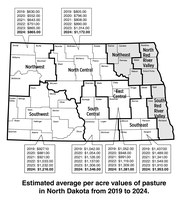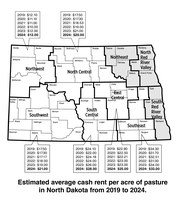North Dakota pastureland values and rental rates continue upward trend
(Click an image below to view a high-resolution image that can be downloaded)
2024 marks the fourth year in a row that pastureland values in North Dakota have increased, says Bryon Parman, North Dakota State University (NDSU) Extension agricultural finance specialist.
From 2023 to 2024, statewide average pastureland values increased 6.63% from $1,273 per acre to $1,355 per acre. This marks the fourth consecutive year that pastureland values have increased since 2021 averaging an annual increase of 6.9% per year during that span.
Pastureland cash rental rates edged up in 2024 as well increasing just over 4% to a statewide average of just over $23 per acre. This is according to the North Dakota Department of Trust Lands Annual Land Survey data which has been weighted for this article by county acreage count and put into NDSU Extension regions. The original survey data can be found at: https://www.land.nd.gov/resources/north-dakota-county-rents-prices-annual-survey. The NDSU regions do not include values for the southern Red River Valley, northern Red River Valley, or the Northeast regions due to very low numbers of reported pastureland rental rates or sales values. Also, single year variation may not reflect actual conditions. It is more useful to look at trends or multi-year movements.
Much like cropland prices in North Dakota, pastureland values have grown significantly faster than cash rental rates for pastureland. From 2014 through 2024, statewide pastureland prices increased at an annual rate of approximately 5%. However, during that same time pastureland interest rates increased at around 2.2% per year or less than half that of pastureland values.
“As of 2024, the rent-to-value rate for pastureland, where the cash rental rate is divided by the land value to estimate a rate of return, was down to 1.7%,” says Parman. “That is essentially saying that, before accounting for management fees or property taxes, the return to pastureland in North Dakota is 1.7%. When those factors are also considered, the return is significantly lower. To put that into historical perspective, as of 1990, the rent-to-value for pastureland was approximately 7% showing that over the last 35 years, pastureland values have greatly outpaced rental rates.”
Parman adds, “Like cropland prices responding to crop commodity prices, pastureland prices and rental rates do respond to cattle prices as well. However, there are nuances and variables that impact pastureland prices differently. For one thing, with crops, a multi-year drought can be overcome more quickly than pasture, as it can take years of additional rainfall to repair damaged rangeland, especially if it was overgrazed during the drought period. Also, following years of drought, cattle may be sold off such that when pastureland has recovered, there are fewer beef cattle inventories and therefore less grazing land needed in the short run. Pastureland can also be highly regionalized such that in areas there are more cattle, those areas command relatively higher rents than areas with fewer cattle, even if areas with fewer cattle would be more productive. Pastureland is also tied to cropland prices in that, even if livestock prices aren’t all that favorable, rising cropland prices can pull pastureland prices up with them.”
“Moving forward, with this spring looking favorable for forage production on range land in North Dakota, and strong beef cattle prices, it is reasonable to expect pastureland values to continue the trend of increasing in value into next year,” Parman says. “Additionally, if strong beef cattle prices continue and inventories increase from their historical low to start 2024, pastureland rental rate increases could pickup over the next few years.”
NDSU Agriculture Communication – May 7, 2024
Source: Bryon Parman, 701-231-8248, bryon.parman@ndsu.edu
Editor: Kelli Anderson, 701-231-7006, kelli.c.anderson@ndsu.edu



